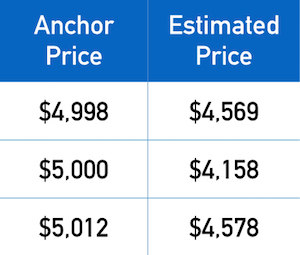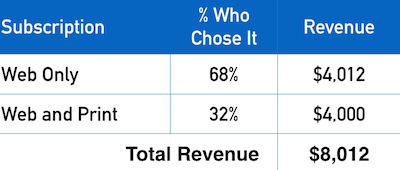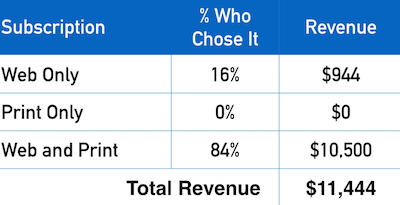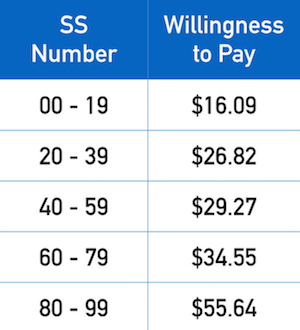As sales tactics is one of the most important and vital aspects of the SaaS sales process, price optimization is a subsequent key ingredient.
Thus, positioning the right price in proposals is an art per se.
Here are few best practices taken from Nick Nolenda‘s excellent price optimization report. The practices are adapted to the SaaS world.
Here is a brief summary (tl;dr ):
1) Remove the $ sign (it reminds the pain of paying).
2) Remove the comma when possible (2599/mo. instead of 2,599/mo.
3) Use precise high numbers as Anchor:
4) Have an Anchor price- Always start with high price
5) Start negotiation with a high precise number.
6) Visually Distinguish Higher Price Comparisons when you compare your price to a higher price.
7) Offer a decoy package (the economist experiment)
8) Expose people to any high number (another form of anchoring)
9) Shift focus towards time-related aspects
10) Use the rule of $100
11) Provide a reason for the discount
12) (VP level tips) Use more frequent (yet smaller) price increase
SaaS Pricing Psychology: the entire list
1) Remove the $ sign (it reminds the pain of paying).

2) Remove the comma when possible (2599/mo. instead of 2,599/mo.).
Besides font size and kerning, another consideration is punctuation. Researchers found that removing commas (e.g., $1,499 vs. $1499) can influence people to perceive your price to be lower

3) Use precise high numbers as Anchor:
Anchor price works and it needs to be precise in order to be credible. For instance use: 4998/mo. (instead of 5000), or 2512 (instead of 2500)
Thomas, Simon, and Kadiyali (2007) analyzed 27,000 real estate transactions. What did they find? Buyers pay more money when prices are specific (e.g., $362,978 vs. $350,000).

4) Have an Anchor price- Always start with high price- you’ll never know what your net can catch if you cast it far. Put a high price tag, then customer will tell you that you’re out of your mind and that the product doesn’t worth more than X. That X might be much higher than your avg. deal price.
A good reference was from Steve Blank when trying to find the right price for his new product:
I ask them, “If the product were free, how many would you actually deploy or use?” The goal is to take pricing away as an issue and see whether the product itself gets customers excited. If it does, I follow up with: “OK, it’s not free. In fact, imagine I charged you $1 million. Would you buy it?” While this may sound like a facetious dialog, I use it all the time. Why? Because more than half the time customers will say something like, “Steve, you’re out of your mind. This product isn’t worth more than $250,000.” I’ve just gotten customers to tell me how much they are willing to pay. Wow.”
― Steven Gary Blank, The Four Steps to the Epiphany
5) Start negotiation with a high precise number.
Due to anchoring, it’s no shocker that sellers can get more money by starting negotiations with a high initial offer (Galinsky & Mussweiler, 2001). That high number establishes an anchor point, pulling the final settlement closer to that range.
Not only should you start with a high initial price, but you should also use a precise value. In one study, Janiszewski and Uy (2008) asked participants to estimate the actual price of a plasma TV based on the suggested retail price — either $4,998, $5,000, or $5,012.

6) Visually Distinguish Higher Price Comparisons When you compare your price to a higher price, people are more likely to buy your product because they feel less motivated to research the decision (Urbany, Bearden, & Weilbaker, 1988). They’ve already done their homework. But here’s a neat psychological trick to enhance that comparison.

7) Offer a decoy package
Oftentimes, people use your own products for reference prices. To ensure that their comparisons are conducive for your bottom line, you should consider adding a “decoy product.”
You might be familiar with the infamous study. In Predictably Irrational, Ariely (2008) describes a strange offering from the Economist magazine. One day, he noticed three subscription options:
- Web Only: $59
- Print Only: $125
- Web and Print: $125
Now let’s take it to Wiser Offering:
Let’s offer two options, assume it would look like that:
- WisePricer CSE Only: $899
- WisePricer 3 sites scrapping only : $1890
How can we convince the client (without telling him) in psychological way to choose the later rather the former? Simple, we add another anchor, a 3rd option that will “help” them to decide.
- WisePricer CSE Only: $899
- WisePricer 3 sites scrapping only : $1890
- WisePricer 3 sites scrapping +CSE: $1990
as you can see now, suddenly option #3 looks much more compelling, as with only $100, you get the entire package (nobody will choose option #2 obviously, but it’s there to make option #3 looks MUCH more appealing)
Here are the results:

However, the “print only” option helped people compare those two options. Because it was a similar, yet worse, version of the “web and print” option, people could easily recognize the value of the web and print subscription. With more people choosing “web and print” (a more expensive alternative), the Economist generated 43% more revenue.


8) Expose people to any high number (another form of anchoring)
Anchoring not only works for prices, but it also works for any number, regardless whether that number is a price.
Here’s a striking example. Ariely, Loewenstein, and Prelec (2003) showed participants various products (e.g., cordless keyboard, rare wine, Belgian chocolates). They asked participants whether they would purchase each product at the dollar amount equal to the last two digits in their social security number.
After receiving a YES/NO answer, researchers then asked participants to state the exact dollar amount they would be willing to pay.
Remarkably, the researchers found a direct correlation between the social security number and the price that participants were willing to pay. Here’s the data for one of the products, a cordless keyboard:

How can you apply that finding? Should you simply ask customers to contemplate a high number? Not quite. Luckily, your job is easier.
Anchoring effects occur subconsciously, so consumers don’t need to contemplate a numerical anchor. In fact, Adaval and Monroe (2002) subliminally exposed people to a high number before displaying a price. That exposure caused people to perceive the subsequent price to be lower.
The takeaway? Even if potential customers don’t consciously notice your numerical anchor, they just need to be exposed to it.
In a SaaS pricing sheet, you could simply mention your total number products, etc. “
When people generate their reference price, that high number will trigger an anchoring effect (and their reference price will be even higher).

In our case:
Total: $2590/mo.
Over 1,000,000 data points/day
9) Shift focus towards time-related aspects
When describing your product, avoid mentioning any references to money. Instead, mention a concept that has a much greater benefit: time.

10) Use the rule of $100:
- When your price is under $100, use a percentage discount (e.g., 25% off).
- When your price is over $100, use an absolute value (e.g., $25 off)
In both cases, you’ll be choosing the discount with the higher numeral (which will influence people’s perception of the magnitude).

11) Provide a reason for the discount
To avoid the negative perception of discounts, you might want to avoid the term “discount.” At the very least, you should give a specific reason for the discount.
“Q3 discounted rate”

12) (VP level tips) Use more frequent (yet smaller) price increase
The easiest way to control price perception is through the just noticeable difference (JND).

You can also, raise the Price of Your Previous Product If you’re launching a new (more expensive) version of your product, how should you price the old product? Some businesses will lower the price of their old product to gradually phase it out of the market. Surprisingly, though, that strategy is often the wrong approach.


 I'm co-founder & CEO @ Wiser, second time entrepreneur bootstrapper, learner, and writer.
I live in San Francisco. This is where I share my thought.
I'm co-founder & CEO @ Wiser, second time entrepreneur bootstrapper, learner, and writer.
I live in San Francisco. This is where I share my thought.
FOLLOW ME ON: